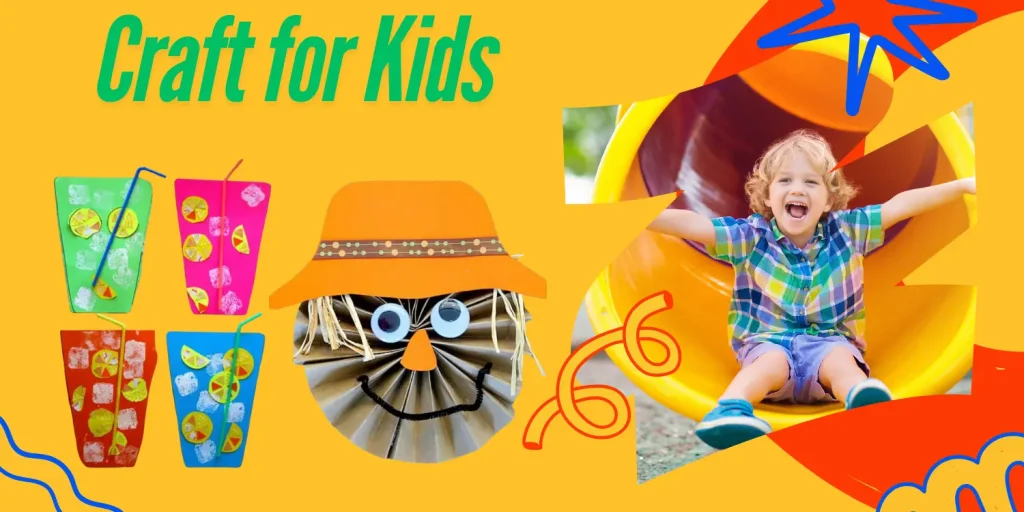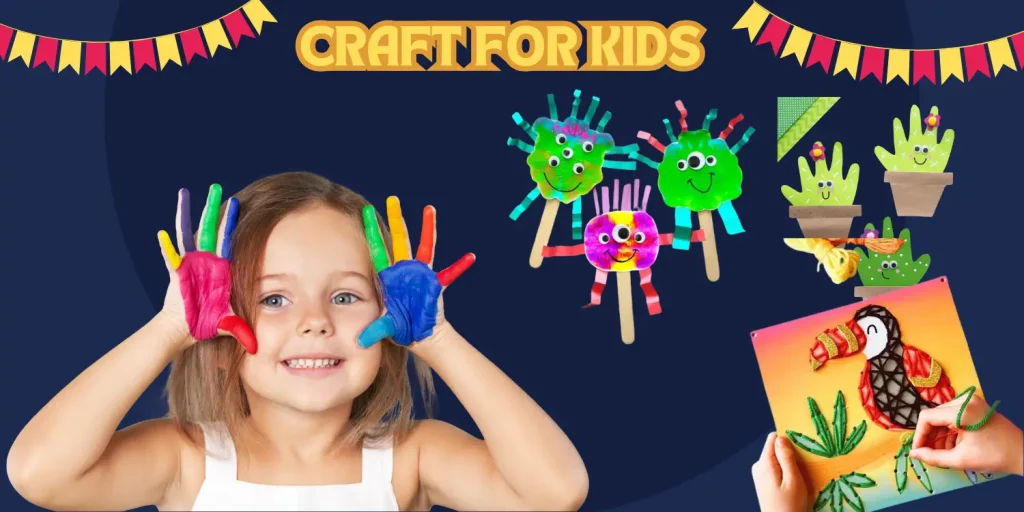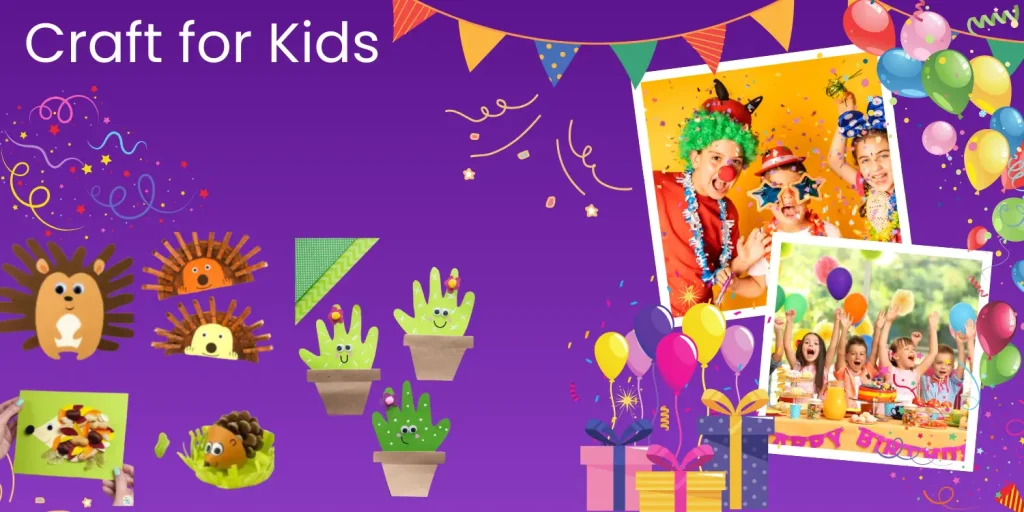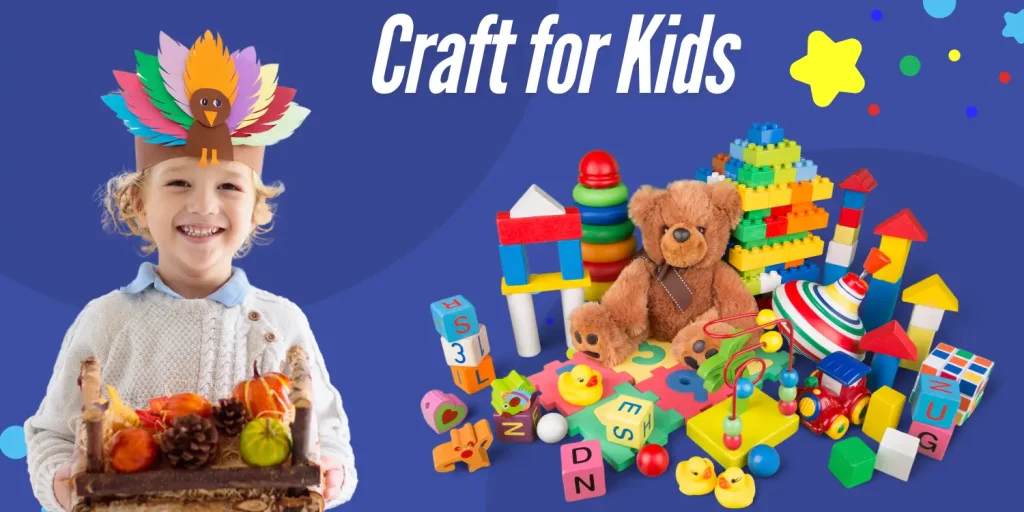Introduction to Craft for Kids
To children, Craft for Kids projects are not mere occupations or pastimes; they are an avenue to creativity and self-expression and an opportunity to learn. In a world dominated by screens and digital entertainment, creating allows children to engage in rich, creative, fine motor activities and enhance their logical thinking skills. Arting offers young people countless opportunities to unleash their creativity and have fun, enjoying painting, sculpting, sewing, or inventing cheerful crafts and DIY.
Besides being fun, there are more educational values of crafting than one might expect. It promotes the development of patience, fine motor skills, and the child’s eye-hand coordination boot. Students are given opportunities to work through problems and use their problem-solving skills to go through stages in a process of cutting, folding, glueing, and assembling objects, which enhances their analytical and organisational skills. Also, the children behave as if the instances of creating such projects work as the main instruction, which involves creation, experimentation, decision-making, and accepting failures.
, the most important benefit obtained from making is having a better sense of mental health. Crafting can allow children to demonstrate their ideas and feelings in a way that is enjoyable without any fear. When a Craft for Kids job is finished, one can be sure of one thing: self-satisfaction and the desire to take up even another project. Since parents and kids may work on projects together or share ideas and create memories that will last a lifetime, it is also a wonderful opportunity for families to become closer.
The same goes for such exposures as sustainability and resourcefulness that children also learn through crafting as well. Students find out how to transform ordinary objects with the help of creativity and learn about the importance of preserving nature and using recyclable and organic products. This helps foster creativeness amongst them in addition to forcing them to become responsible.
It is a good strategy of integrating Craft for Kids projects for children as it enhances their creativity, skills, as well as their personality. Thus, creativity and creativity through creating should be considered rather useful and positive components of childhood.

What Are Crafts for Kids?
Children’s Art are creative activities that require children’s creativity, their fine and gross motor coordination, and problem-solving skills with the use of practical objects. Such projects typically involve making fun and lively objects using different materials such as papers, adhesives, scissors, markers, paints, fabrics, beads, and clay. We get the opportunity to draw, get a new skill, make friends, and even gossip while doing Craft for Kids, and this is fun for kids.
Another outstanding qualification of crafts for children is that the work promotes creativity. They can achieve what they want by exercising creativity regarding the colors, shapes, and textures of the media. The children are able to express themselves naturally, being able to draw without any hindrance and make errors while making greeting cards, paper animals, picture frames, and the like.
Art and crafts are also beneficial for enhancing hand-eye coordination and fine motor skills. Some of the specific movements that can be cut, folded, threaded, and glued can make children better writers and help with other relevant chores. Also, when children engage in a certain project in an endeavour to complete it, most times knowledge is imparted on patience and concentration.
The versatility of crafts is still another wonderful characteristic. They may be adapted based on skill, interest, and age-ability with relative ease in order to meet the needs of the different learners.
For young children, basic artworks such as paper-recycle art or finger painting art will do. Sewing, woodworking, or model making may attract children of a higher age, say 8 years old and above, or even teenagers.
Group projects can be assigned to children, ideas shared, as well as the final products admired by every individual; crafting can also be grouped to be social. They promote work accomplishment and, at the same time, foster notions of communication and teamwork.
In conclusion, children’s crafts are not just some activity or pastime; they are a valuable tool that helps children to have fun and learn actively. They allow children to have fun, explore the environment, and, in the same process, teach them artistry.

Why Do Kids Love Crafts?
Why are crafts of special interest to children? This is because crafts fit with a conception that children like what is creative, fun, and productive of tangible outcomes. Children are naturally curious beings, and what can better capture that curiosity and inventions than through crafting?
Despite what children seek in crafts beyond satisfaction and leisure, crafting can offer social, emotional, and developmental perks that will benefit the children.
Finally, children can create something out of art projects and let out whatever they have inside them. Every work done, whether it is a finger painting or clay sculpture, is very much an idea, feeling, and interest.
Controlled reactions give children a limited means of expression regarding their individuality and allow them to pick colors, forms, and patterns, unlike crafts. Self-esteem and pride in their abilities stem from such company ownership.
Also, crafts give the children a better chance to learn taking physical activities. Making also involves the knife cutting for a child, glueing, and assembling, which generally enhance the children’s fine motor control. While the children come up with ways of putting ideas into practice, it fosters problem-solving aspects. They get to learn new things in everything from arithmetic, physics, and even history through crafting. For instance, they can study ethnic traditions through the ornaments used during the holidays or understand symmetry in origami works.
Haptic feedback is another reason why crafting has been an interesting activity to engage in because it provides a sensory feeling. Their touch, sight, and even smell are engaged in interaction with paint, glue, and paper, which makes the activity enjoyable and more hoped for. The younger children need this so much, as this will assist them in exploring and making sense of the environment.
On the emotional level, crafts are also useful for children. For instance, the up-and-down movements in weaving the basket or painting the picture make people uneasy and full of anxiety. Also, it provides protection for nonverbal conflict resolution and emotional regulation. According to the above analysis, learners feel accomplished when they engage in a creative activity to complete a project, which leads to high self-esteem.
Besides, crafting is a process that involves people. It fosters teamwork and interaction when done in the classroom, as a group meeting, or even within the family. It also builds friendship and teamwork for children to share resources and ideas, as well as appreciate each other’s work.
Children love crafts because they provide a way to make something worth building, and learning is not boring after all. Making ordinary items into delightful or practical ones is profoundly satisfying and cultivates a lifelong passion for making things. Making something creative is fun, educational, and rewarding.

How Do Crafts Help Kids?
Crafts are also beneficial to children in general development because the activities offered are not mere entertainment for the kids. As many would agree, crafts have multiple and important benefits, including the following: As many would agree, crafts have multipurpose—and important—uses, including the following:
1. Improving Dexterity
Fine coordination can also be established when children engage in other planning and executing tasks, for instance, in painting with brushes, cutting with scissors, or when handling beads while threading them. Having specifically focused on strengthening the small muscles within the hands and fingers, such exercises prepare young learners for writing, shoelace tying, and using cutlery.
- Creating Imagination
Through crafting, children are free to come up with unique ideas and encouraged to think outside the box. Through games, they can learn colors as well as materials, shapes, and other features; this is a way of encouraging their imaginations to grow. Free-thinking children come up with better mechanisms of tackling various challenges as well as enhanced creativity.
3. Building self-esteem or confidence
Children are pleased when they are through with a craft project. In all sorts of card-making activities—painting a picture or constructing a model—the tangible end products are reassuring. This achievement builds up the confidence of the workers, who ensure that they undertake other activities.
4. Promoting an outpouring of emotions
Crafts can also be an excellent way through which children can depict their emotions and therapeutic abilities. While words may not be enough, art can depict the situation. Any child who is going through anxiety, stress, or other similar concerns will find this incredibly useful to handle them.
5. Popular for Enhancing and Boosting of Concentration and Patience
Children are constantly required to listen and obey, as well as spend time perfecting their work during crafts. They have to learn patience in the process, and the sharpness of their focus becomes enhanced. It is assumed that these abilities will lead to the increased concentration on the everyday tasks and thinking in the future.- 6. Improving social capabilities
Group craft involves activities that help in encouraging team players, and this includes carrying out crafts. Students learn how to share items, take and give constructive criticism, and work together for efficient end-product accomplishment. These exchanges help build interpersonal skills for sharing, feeling, and working together.
7. Cultivating love for school
Anything that involves turning learning themes into artistic projects can make studying fun, for instance, making alphabet flashcards or model solar systems. This very practical technique endows the thoughts with tangible and long-lasting manifestations.
Taking everything into account, crafts are proven to be efficient in contributing not only to the children’s cognitive and emotional growth but also to their physical development as well as satisfying the aesthetic and joyful curiosity of children in everyday life experiences.

What Are the Five Uses of Craft?
Artistry is the skillful creation of objects or products that often have social, cultural, aesthetic, or practical uses. Craft has always been an integral part of human civilisation because it has always benefitted in closing the gap between art and utility. The five main purposes of craft are discussed below: as a use-value, an aesthetic value, an anthropological value, a monetary value, and an individual or psychological value.
__|_________________
1. Practical Use
One of the simplest benefits of craft is where it belongs: as a useful form of play. For basic necessities such as clothing, housing, and equipment, many crafts were developed to meet basic human needs. Sewing for clothes, carpentry for chairs or tables, and pottery for storing food among them. Sculpting is still very important in today’s world to make beauty and usefulness of products.
Even carved spoons or handcrafted chairs and tables, for instance, offer a combination of power and aesthetics; a handcrafted pot improves the dining experience, as well as a tool to be used in cooking or eating. This is a common feature where the emphasis on long-lasting and quality materials, more often than not, sets apart the handcrafted from the factory-made designs.
The conservation of Aktidae is providing vital attempts at a critical moment of its development; ______________________________________
2. Expression of Art
Craft allows people to express their individual style and creativity. Craft often involves the creation of solid, tangible things, unlike the fine arts, and art crafts are often more abstract. Nonetheless, due to the complex design and delicate workmanship, many handcrafted products are in between art and craft. For example, well-selected categories, such as quilting, glassblowing, and jewelry making, are not only functional utility instruments but also art pieces. Creativeness enables the artist to introduce new designs, cultural stories, or even individual narratives in the product.
________________________________________
3. Preservation of Culture
Handmade is important in as much as it helps in passing on generational cultures and beliefs. The cultural heritage of indigenous and traditional crafts all over the world is the history, beliefs, or values of a particular community. As a way of protecting culture, techniques, media, and processes often pass down from one generation to the other. For instance, African beads, Indian block printing, and Japanese ceramics all tell a certain story about the area’s history and culture. It is imperative to keep practicing traditional art and crafts because they are a sign of cultural difference on a planet that is progressively tightening its globalisation bonds.
Omissions are as follows: Subscription Services Data Network: __________________________________________________________
4. Financial Subsistence
For many people and groups, craft is paramount and their chief source of revenue. Cultural and artisanal production is often the most widespread form of remuneration in locations where industrialisation is not developed. Society is becoming more conscious of factors like slow living and sustainability, translating into demand for a unique, artisanal product, even in postindustrial cultures.
Through the fashion of marketing their products in the markets, online selling sites, or galleries, several artisans and crafters contribute to both the domestic and global economy. Apart from creating a constant market for the sale of their crafts, fair-trade programs and craft cooperatives also support underprivileged communities.
This evaluation was used, __________________________________________, to facilitate a depth of understanding that would have been impossible had the researchers been solo operatives working independently on the project.
5. E-enhancement of the self and therapy
Sewing is one of the most popular among your hobbies and crafts, as it yields psychological and emotional benefits and is a wonderful way to spend time. Sewing might be a very mindful process that has the potential to reduce stress levels among individuals. It allows individuals to concentrate on tangible tasks and work with ideas while staying away from the digital speed.
Moreover, it also often uses art-making, especially for people with anxiety, trauma, or cognitive impairment. Games, knitting, painting, the making of ceramics, and various other artifacts fall into this category because exercise boosts motor skills, engenders social contact, and results in feelings of achievement.
Beneficial effects of direct selling, the key arguments of the direct selling critics, and approaches used in direct selling are also the parts of the present research.

How to Get a Craft for Kids Online
Purchasing children’s crafts on the Internet might be quite entertaining and useful if looking for interesting activities that would help little ones develop creativity and keep their busy fingers busy. Here’s a detailed guide to help you find the ideal kids’ craft online:
1. They reveal their interests and the age group targeting by the company as well.
Before you start browsing, consider whether the child is old enough to understand what they’re doing and what they are interested in. While the older children could possibly prefer such complex work as constructing models, jewellery making, or painting sets, the younger children will possibly prefer simple items such as colouring books, stickers, or simple pre-cut sets.
- Choose the proper networks.
You should begin at some general stores like Amazon or Walmart or some speciality stores like Joann Fabrics and Michaels. On the other hand, unique and delicate craft kits that are made by hand are developed based on age and topic and can be purchased on sites such as Etsy.
3. Keyword implementation is another technique that should be applied in the context of creating augmented content.
Always type in words like “holiday crafts for kids, craft kits for five-year-olds, or STEM craft kits if you wish to narrow your search results. This will help you to filter for solutions that would suit your needs.
4. Examine product descriptions
For this reason, to determine what is in the kit, it is important that consumers read the various product descriptions. Search for information about the supplies, the equipment, and the guidelines. Some of them will come with all the materials you’ll need, while others might require additional accessories such as scissors or glue.
5. Examine ratings and reviews
Testimonials can include information used by customers and contain valuable feedback on the craft kit. Ask for comments from parents or teachers, especially those who comment on how much youngsters enjoyed the activity.
6. Which education has a greater value?
Many craft kits are designed to develop skills such as creativity, problem-solving, as well as hand and finger dexterity. The additional fun is possible if the kits are STEM-related or have a specific theme (space, wildlife, etc.).
7. Now, type in Packages and Discounts.
Usually, craft kits are sold in sets or as part of a multi-buy order. Search for coupons, restricted offers, or any other site that offers discounted prices with free shipping options.
8. Research Rules and Delivery Time
To avoid getting disappointed, look at some factors, such as the return policy, and give an expected date before the craft can be delivered in case you need the craft for a special event like birthdays or during the holidays.
9. Examine Subscription Services
If you have a child who loves crafts, then for consistent play, try a monthly subscription service such as KiwiCo, Green Kid Crafts, or Creation Crate. The following businesses bring a brand new craft kit every month right to your doorstep.
By the following instructions, you can find out the desirable project and choose one accurately to meet the child’s interests and provide hours of imaginative fun!

Features of Craft for Kids
That is why children’s crafts are so enjoyable but also productive and educational at the same time. These activities provide children with ideas and also teach skills needed for the activities, which are very important for the children. The following are some essential components of children’s craft projects:
1. Accessibility and simplification
Children’s craft assignments are often concrete, simple to follow, and accompanied by clear instructions. Stationery products such as paper, glue, scissors, markers, and old items that can be recycled or used again are usually cheap and easy to obtain. This is why children of all abilities can participate with tremendous ease.
- Age-Related Styles
It’s important to choose crafts with specific occasions in mind with respect to the age of the children; they should not be too difficult to accomplish nor too easy. Young children, perhaps in the preschool age, might engage in some simple artwork, such as finger painting; on the other hand, more advanced students may try out some projects like sewing or building models.
3. Emphasis on originality.
These exercises help children hear their own ideas in their heads and think creatively. They are creating their own cards, decorating and making items, and even drawing their own characters.
4. The development of skills
The children who craft get to develop their hand-eye coordination, the ability to handle small objects, and mental rigor. Focus is achieved in fine motor skills such as using scissors, origami, or intended in using thread and beads.
5. Educational Worth
Many crafts involve learning letters, numbers, colors, shapes, and the like. They can also help kids learn cultural customs by using thematic projects on holidays or creating decorations for the corresponding seasons.
6. Increasing Self-Belief
Children feel like they have accomplished something whenever they complete doing a craft. This they achieve so much without realising it as their confidence increases, and they can be encouraged to take on more challenging assignments.
7. Sustainable Choices
Many craft ideas involve simple or recycled materials, thereby being less draining on a parent’s purse while at the same time fostering the imagination of the children as well as passing on values of conservation.
Children’s activities for crafting are fun and can be intellectually engaging for kids’ brains because the things they make as they play are real.

Craft for Kids: Conclusion
In my opinion, crafting with children is not only a way to have fun, but it helps them to develop creativity, education, and emotional regulation besides. Making helps children develop fine motor skills and creates space for thinking through their ideas and inspiring them with confidence that they can create something new. These forms of learning activities that involve painting, sculpture, among others, nurture kids and help them enjoy the creativity.
Also, it is a precious opportunity to develop relationships with clients and/or customers as well. When parents, educators, or any other carers are also involved, it emerges into social interest that enhances cohesiveness and creates memorable moments. It is a time where successes can be acknowledged, and no matter how small, shared joy can be found, as well as idea swapping. Even mundane crafts can trigger a conversation that will lead to a teaching moment or, better yet, create as much fun for parents as it does for kids.
Further, making fosters tenacity, patience, and problem-solving skills that are found to develop in a child. The children learn we are able to overcome challenges when they are provided with challenges like choosing the right colour combination or even learning how the parts have to be glued together. These problem-solving capabilities form the basis of their general growth as well as every other aspect of their existence.
The process is better than the product: that is why it is so much fun to knit. The implementation, the mistakes, and the breakthroughs are all made really good here. Besides kindling children’s imagination, let them learn the importance of this journey, practicing on the road to work and to find.
On the next crafting enterprise, bear in mind that the purpose of these activities is enjoyment and engagement as opposed to accuracy. Children craft for creativity, development, community, and, simultaneously, So gather your materials, let out your creative juices, and take ultimate benefit of this age-old hobby!
